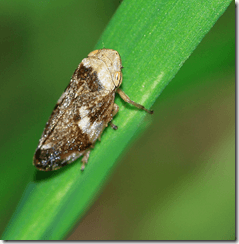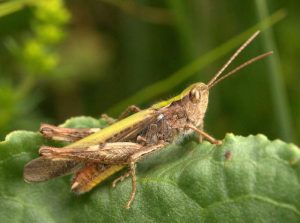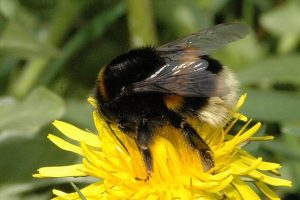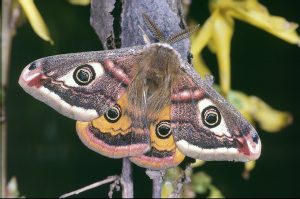 Have you ever wondered what makes those little balls of froth, popularly known as “cuckoo spit”, that you find on plant stems during the summer? Blow gently on the froth and you’ll find your answer. Inside the frothy mass you’ll find one or more yellow-green insect nymphs – the young of the common frog hopper, also known as the cuckoo spit bug or spittle bug.
Have you ever wondered what makes those little balls of froth, popularly known as “cuckoo spit”, that you find on plant stems during the summer? Blow gently on the froth and you’ll find your answer. Inside the frothy mass you’ll find one or more yellow-green insect nymphs – the young of the common frog hopper, also known as the cuckoo spit bug or spittle bug.
The common frog hopper is a remarkable little insect that’s common all over Ireland. Recent research showed that that this unassuming creature, which only reaches 6-8 mm (c. 0.25 inch) in length, can catapult itself up to 70cm (c. 28 inches) into the air – a statistic that makes it a true champion among natures jumping fraternity. Although the flea achieves a similar height, the frog hopper, at around 12 milligrams (0.0004 oz), is up to 60 times heavier than the average flea, making its jumping performance that much more impressive.
Frog hoppers are found in a wide variety of habitats, and are common in gardens, parks and meadows on a wide variety of plant species. In fact wherever suitable food plants grow you’re likely to find frog hoppers and their nymphs from around June to September.
In common with other bugs (Hemiptera) frog hoppers have specially adapted mouth parts that allow them to suck the sap from the stems of living plants. At rest they hold their wings tent-like over their body. Adult frog hoppers vary enormously in colour. Most tend to be a pale mottled brown, but they can also be yellow, green, almost black, striped, dark brown – even purple!
Like most other bugs frog hoppers mate back to back, and adults can sometimes be seen locked together in such a manner. They follow a pattern of insect development known as “hemimetabolous development” – which means there are no larval stages and metamorphoses as with many other insects. Instead frog hoppers develop through a series of wingless nymph stages that largely resemble adult insects. The nymphs produce the protective cocoon of froth by blowing air through a fluid excreted from their anus. This protective layer of froth not only conceals them from predators, but also protects them from the potentially fatal drying effects of the sun and wind.
The secret to the frog hoppers record breaking jump is its back pair of legs. These are extremely specialised, and are used exclusively for jumping. They are so well developed that they are no use at all for walking, and simply trail behind the insect’s body as it moves around. When employed for jumping, however, these back legs form the centrepiece of an incredibly powerful catapult system. The legs are folded in a cocked position, held in place by special ridges. Two huge muscles (one for each leg) are then contracted building up tremendous force until the legs finally break free. All of the pent-up force is released instantaneously, propelling the insect at an incredible velocity.
Anyone who’s seen a frog-hopper jump will attest to this speed. One moment the insect is there, the next it’s gone. In fact the velocity generated during the early stages of a frog-hopper jump generates a staggering G-force of over 400. That’s a pretty impressive statistic when you consider that an astronaut rocketing into orbit around the earth experiences no more than a paltry 5 Gs.
S7AZPHR9E2PU










9 comments
Crescentia Phelan
I live in Laois. I have noticed this spit on my lavender plants. I watered them last night and it is back on them this morning. How do I get rid of it.
Calvin Jones
You don’t need to — they are just the nymphs of a completely harmless native insect called a frog-hopper. They do no damage to your plants and pose no risk to you. This issue is only cropping up because of sensationalist media reports around a bacterial disease called Xylella fastidiosaJust, which at present doesn’t occur in Ireland.
The best way to avoid/prevent Xylella? Stop importing plants from the continent plant native species, or only buy imported plants that you know have been properly screened to be disease free before arriving in this country.
Glenn
I have white foam on 22 mature lavender plants in my garden which indicates spittil bug, should this be washed of or plants removed. I live by the coast in County meath
Calvin Jones
No — why would you do that? These are just the nymphs of common frog-hoppers/leaf hoppers and do no harm to the plants or anything else. There is only an issue if/when a disease called Xylella fastidiosa (unrelated to the insect) is present in the area, as the bugs can act as inadvertent vectors of the bacterial pathogen. As far as I know, while Xyllela is a problem in parts of mainland Europe it has not been recorded in Ireland or the UK to date, so there’s no need for you to do anything.
Marian Naughton
I love your article on frog hoppers. I need to remove some docks from my wild garden but without harming my little frog hopper nymphs. Can they relocate easily to other plants if I lift the plants they are on? Many thanks for your article and any advice. Marian Naughton
JimWaldron
BBC News has a report today about an insect that has devastated olive trees in Southern Europe.It looks and behaves very like the frog hopper/ “cuckoo spit”” although the report pointed out this insect has not yet entered the UK. Are we looking at two different insects here?
Calvin Jones
Yes, different insects Jim — the Cuckoo Spit you see here in Ireland and the UK is created by the nymph of the Common Frog Hopper — a native species that’s widespread throughout the region.
Colm
The froghoppers aren’t the direct cause of the devastation but they and other sap-suckers are acting as a host for a bacteria called Xylella fastidiosa, which is. Because of this, in the UK and Ireland we’re being asked to record froghopper populations so that if X. fastidiosa turns up, strategies can be well-informed.